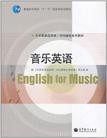音乐英语
出版时间:2011-6 出版社:高等教育出版社 作者:《大学英语先修课/学科课程系列教材》项目组 编 页数:209
内容概要
《普通高等教育“十一五”国家级规划教材·大学英语选修课系列·学科课程系列教材:音乐英语》以“全语言教学法”、“任务教学法”为指导,按照“leam bydoing”的现代教育理念,从音乐专业学生的学习需求出发,将音乐专业相关资料的听、说、读、写、译活动贯穿于一系列任务之中,使学生在完成这些任务的过程中,了解专业知识,习得专业英语技能。本教材不仅提供了阅读材料,还为音乐专业学生提高听、说、写技能提供了范例和应用机会,为学生将来的国际交流打下基础。
书籍目录
Unit 1 Musical lnstrumentsUnit 2 Musical ProfessionsUnit 3 Musical StylesUnit 4 Music HistoryUnit 5 Important People and Bands in MusicUnit 6 Basic Concepts in MusicUnit 7 Fundamentals of Music TheoryUnit 8 Music EducationUnit 9 Famous Musical WorksUnit 10 ConcertsGlossary
章节摘录
Traditional Chinese music is more melodic rather than harmonic. Chinese vocal music probably developed from sung poems and verses with music. Instrumental pieces played on an erhu or dizi are popular, and are often available outside China, but the pipa and zheng music, which are more traditional, are more popular in China herself. The guqin is perhaps the most revered instrument in China. The zheng is most popular in Henan, Chaozhou, Hakka and Shandong. The pipa believed to have been introduced from the Arabian Peninsula area during the 6th century and adopted to suit Chinese tastes, is most popular in Shanghai and the surrounding areas. Beijing opera, still referred to by many English-speakers as Peking opera, is one of the most highly developed and best known of Chinese opera forms both in China and abroad. Before the 20th century, Beijing opera was not commonly performed outside Beijing and a few other centres. Its enormous popularity in the early 20th century, however, carried it to the status of "national opera". Most traditional Beijing opera music belongs to either the xipi or erhuang tune families. The combination of these two families was so integral to the opera's identity that in the past, before it was called Beijing opera (jingxi orjingju), the genre was known as pihuang opera (pihuangxi), combining the pi from xipi and the huang from erhuang. ……
图书封面
评论、评分、阅读与下载
用户评论 (总计0条)
相关图书
- 综合英语教程2
- 分心也有好人生
- 课堂教学综合训练教程
- 大学生实习实用手册
- 中国民族音乐及作品鉴赏
- 中国武术段位制系列教程-螳螂拳
- 中国武术段位制系列教程-翻子拳
- 舞蹈
- 中国现代高等口腔医学教育发展史
- 长白山动物学综合实习指导
- 园艺植物遗传育种
- 2011在职法硕在职攻读法律硕士联考
- 2011年在职攻读法律硕士专业学位研究生招生联考专业综合考试教程
- 2011年在职攻读法律硕士专业学位研究生招生联考专业综合考试大纲
- 全国计算机等级考试全能教程-二级C语言
- 动态网页设计
- 外贸单证实务
- 应用统计学
- 中国投资学科建设研究
- 九年级数学(上 浙教版)
- 民事行政检察指导与研究
- 考进实验班(初中数学)
- 课时新体验新理念+新设计(4上)
- 课时新体验新理念+新设计语文(2上)
- 课时新体验新理念+新设计(1上)
